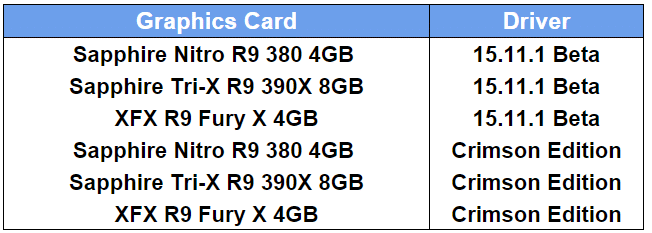AMD Radeon: Crimson Edition First Look
Rikki Wright / 9 years ago
Test Systems and Procedures
Before we delve into any testing we would like to take this opportunity to overview our test system. All tests will be conducted with the latest stable drivers available, with results will be taken from an average of three tests. All tests will be conducted using the highest factory setting if multiple options are available.
Hardware
- Motherboard – Gigabyte X99-Gaming G1 WiFi LGA 2011-3 Motherboard
- Processor – Intel Core i7 5820K at Stock 3.3GHz
- RAM – 16GB (4 X 4GB) Crucial Ballistix Sport DDR4 2400MHz
- CPU Cooler – Thermaltake Water 3.0 with Gelid GC-Extreme
- Power Supply – BeQuiet Dark Power Pro 11 1200W
- Main Storage Drive – Crucial M550 512GB
- Chassis – Lian Li T80 Test Bench
- Displays – AOC U2868PQU 4K
- Operating System – Windows 8.1 Pro 64 Bit
Drivers
These three cards were chosen to keep the results as concise as possible. The R9 390X is based on older architecture and GCN 1.1, the R9 380 is based on slightly newer architecture and GCN 1.2; finally the R9 Fury X has the newest architecture with GCN 1.2 and High Bandwidth Memory.

Software
- Tomb Raider – Medium Preset – 1080p Fullscreen
- Unigine Heaven – Basic Preset – 1080p Fullscreen
- Google Chrome – Youtube web page – 4K Fullscreen
Performance
Performance is a key part of choosing a graphics card and can sometimes come down to just a few Frames Per Second difference. While this isn’t a full performance summary of Crimson Edition, a small portion of performance tests will run to attain sufficient information to base a summary on.
Power Consumption
With electricity becoming increasingly expensive across most parts of the world, the need for computer components to become power efficient has never been more relevant. Graphics cards are often the most power-hungry components inside a desktop system so having an efficient graphics card is very important to keeping power bills under control. Power is often correlated to heat and so lower power consumption means a graphics card is likely to run slightly cooler and put out less heat into your system meaning your other components will run cooler with improved longevity.



















